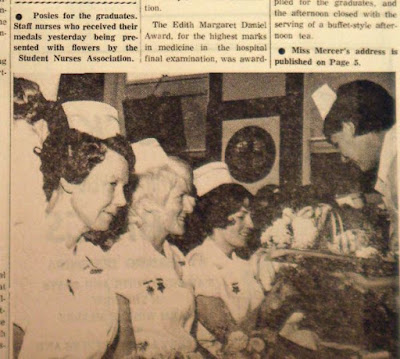No single day at the Thames Museum is the same. While overseas travel has been put on hold, visitors still come from around New Zealand. While some have no links to Thames, the volunteers on duty often get to meet and talk with people who have Thames names in their family tree. Here is the story of a very special visitor, who is related to a very 'special' Thamesite.
BACKGROUND:
The Thames Hospital School of Nursing was founded c1900. In 1901 nursing changed with the introduction of Nurses' Registration in 1901. Under Matron Stewart's guidance a successful training school was established - nurses came from all around New Zealand to undertake the three year training programme. Successful probationers were awarded the Thames Hospital certificate, they then went on to sit the New Zealand State examinations - once passed they they were awarded State registration.
Miss Jessie Emma Linton was born at Fielding in 1888, the daughter of Emma and Francis Linton. Jessie was the eldest of eleven children. Birth Registrations at NZ BMD for her other siblings are:1889/4641 Linton Margaret Grace; 1890/14259 Linton Robert Charles; 1892/11677 Linton Annie Lyle; 1895/15505 Linton Andrew William; 1897/5563 Linton Barbara Elizabeth; 1899/342 Linton Isabel Zanna Emma; 1901/7807 Linton Francis Armstrong; 1904/5675 Linton Alister Murray; 1905/19354 Linton Harvey Little. and 1908/23585 Linton Janet Ellen.
The Linton family moved around the Manawatu, to Taranaki and to the Te Awamatu region. By 1914,Jessie had decided to undertake her nursing training at Thames Hospital. Trainee nurses lived at the hospital in accommodation provided in the central two-storied wing of the hospital which faced Baillie Street. This 'second' hospital was opened in 1900 and boasted modern equipment supplemented by the modern nursing methods that Matron Stewart implemented.

In the June 1917 examinations, four nurses from Thames Hospital passed with marks over 75%. They were: Fanny Maria Warren, Christina Pilkington, Jessie Emma Linton and Daisy Sage. That year 93 Nurses sat throughout New Zealand, with 83 Nurses passing the three papers (consisting of Medical, Surgical and Oral sections). In August 1917, the hard work had paid off and Staff Nurse Linton was officially registered, number 2179 on the Nurses' Register.






















































































